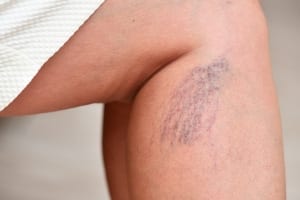Herzliya Medical Center
Tel: +972-9-959-4888
09:00-18:00
 Varicose veins in the legs are veins that are not functioning properly, causing blood to accumulate in them, instead of draining the blood and transferring it upwards, towards the heart. When varicose veins develop in the legs, they can cause an esthetic eyesore (in the form of blue or purple-colored protruding veins), and also health problems: a sensation of heaviness and weakness in the legs, itching, pain, problems with blood flow to the entire leg and even the development of ulcers in the region. The development of varicose veins in the legs, therefore, needs treatment.
Varicose veins in the legs are veins that are not functioning properly, causing blood to accumulate in them, instead of draining the blood and transferring it upwards, towards the heart. When varicose veins develop in the legs, they can cause an esthetic eyesore (in the form of blue or purple-colored protruding veins), and also health problems: a sensation of heaviness and weakness in the legs, itching, pain, problems with blood flow to the entire leg and even the development of ulcers in the region. The development of varicose veins in the legs, therefore, needs treatment.
What causes varicose veins? The crux of the problem is impaired function of valves in the veins: normally, the valves in the veins should allow blood to flow in one direction only – upwards from the legs to the heart, to the lungs and to the kidneys, where the blood is ‘cleaned’ and sent back to the body. Sometimes, the function of the valves is impaired, and the blood flows downwards and remains “stuck” in the legs, so to speak. This causes accumulation of blood in these veins and widening of the veins. Later, the symptoms mentioned above begin to appear.
The main cause of varicose veins is genetic, although there are some factors that increase the chance for their occurrence: prolonged standing, prolonged sitting, pregnancy, obesity, muscle weakness in the region of the legs, and others.
The occurrence of varicose veins in the legs requires treatment, as mentioned above, but the treatment may be conservative if the disease is in its initial stages. In such a case, varicose veins may be treated using special elastic stockings, by walking a lot (which contributes to improved blood flow to the legs), and of course, by reducing factors that encourage the development of varicose veins, if possible.
If these treatments do not help to improve the condition, or in case the varicose veins are discovered at a relatively advanced stage, more substantial treatment will usually be chosen. In the past, varicose veins in the legs were treated by one method: a vein operation, known as vein stripping, in which the problematic vein is removed. This operation is still in use today, but much less often, thanks to more effective treatment methods that require shorter recovery times: blocking of the veins using special foam, laser treatment, treatment with radio waves, and more.
Stripping surgery is performed under general anesthesia or under deep sedation, so if this is what you are going to undergo, you will be required to fast beforehand. The other procedures do not require special preparation and are usually performed under local anesthesia.
In the case of stripping surgery, you will be anesthetized by the method chosen by the physician in consultation with you, after which the physician will remove the problematic vein. The operation is performed via the groin, during which the physician needs to make a few incisions along the length of the leg, in areas in which the sick veins are located.
Blocking of the vein using foam is performed under ultrasound guidance, using a special thin needle. This is a procedure that is performed under local anesthesia, as mentioned above, in which foam is introduced into the vein, blocking it and even causing it to be absorbed into the body later. Blood will continue to flow normally afterward, through nearby veins that are functioning well.
Two additional procedures – use of laser and of radio waves – work by a similar principle: an optic fiber is introduced into the problematic vein and heats it up, effecting its destruction. It is later absorbed into the body, just as with foam injection, and will no longer be part of the blood circulation.
In these treatments, recovery will be relatively rapid, and discharge from the hospital will generally be received on the same day or on the day after the procedure.
It should be noted that most of the newer treatments may be unsuitable for patients suffering from many and branched varicose veins in the legs. Before the treatment and during the diagnosis, the physician will consult with you and decide which procedure is the most suitable for you.
Stripping surgery is considered to have a relatively difficult recovery, and it is therefore performed less and less today. One of its main side effects is a recurrence of varicose veins in the legs, sometimes right in the same area. With other methods, the main risk is an infection or bleeding where the treatment is performed, but these occur in rare instances.